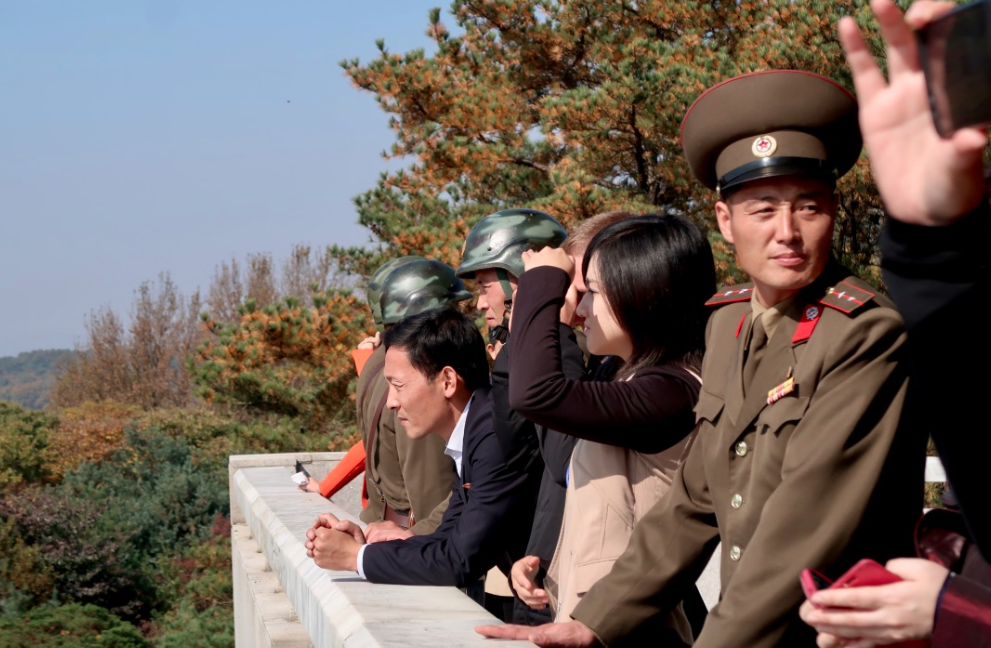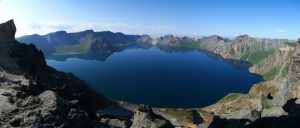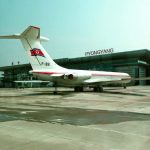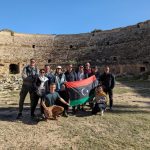When I first peered into the secretive land of DPRK, the year was 2011 and I did so in the company of hundreds of like-minded tourists. I had travelled from Seoul to the DMZ with high hopes of seeing some kind of activity across the 38th parallel. After queuing for nearly 20 minutes, I finally got my hands on a pair of fixed binoculars at a viewing point near the border and frantically searched for movement. I spotted what looked like a few dots toiling in the distance and for me at that time, this fleeting glimpse of North Korean life managed to somewhat satisfy my curiosities. “Oh well”, I rationalized, “without actually going into the country, that’s as close as I’m going to get.”

Three years and five trips to the DPRK later, I happily found myself on a week-long trip along the Sino Korean border. As my fellow travelers and I meandered along the Tumen and Yalu rivers, stopping in Korean influenced towns, walking on ice covered portions of the river, getting searched by army patrols, and standing within talking distance of DPR Koreans, I realized that my earlier realization whilst looking through the binoculars could not have been more off the mark.
After a four day visit to the DPRK’s Special Economic Zone of Rason, Gareth, Rowan, Pier, George, a rather bemused Chinese driver, and I began our borderlands adventure in the Korean influenced eastern Chinese city of Yanji. Yanji is a fantastically Korean influenced city and due to its proximity to the Russian border a pleasant “Zdravstvuyte!” followed us wherever we tread. We spent the night here and then early the next morning made the short trip to Tumen.
For this particular trip, Tumen, due to its large Sino-Korean border crossing, was a particular highlight for us. In 2011, Troy Collings in his capacity as YPT’s DPRK Director of Operations became the first westerner to cross this infamous border into the North Hamgyong province of North Korea. Since then, YPT has taken dozens of tourists across the bridge and all have acknowledged that although any trip into the DPRK is special, there is something surreal about making the journey by foot.
Nevertheless, the cross-border journey was not on this particular itinerary and so, like any group of unwanted voyeurs worth their salt, we instead expressed our fascination from what we thought was a relatively safe distance.
We found it startling that although Tumen has erected a large fortress type barricade, presumably built to dissuade would-be migrants from Korea, ladders reaching to the top could be found sporadically dotted about the wall. In keeping with a common reaction from border residents throughout the trip, our Chinese driver seemed genuinely confused by our excitement at seeing both local north Koreans and soldiers from the Korean People’s Army (KPA) walking along the banks of the Tumen River less than 100 meters away.
Signs had been erected to warn not to advance any further but, like a big red button that you’re not supposed to push, the fearless five advanced through the shrubbery and trees and emerged to find the river completely frozen over. We took a couple of steps onto the frozen river but were stopped in our tracks by gun-wielding KPA soldiers in Korea and angry orders from the guards in China. If our bravery was not wholly evident in this, its dissipation certainly was as we clambered back over the ice, through the shrubbery, up the steps and into the relative safety of a bundle of shops selling unique Korean souvenirs. After necking a bottle of Soju and picking up a few sought-after items that are not available to tourists in the DPRK itself, we got back on our tour bus and continued on our adventure. Unspoken as it was, there undoubtedly existed on the bus a collective belief that being targeted by the Korean People’s Army was enough excitement for one day. Enter, People’s Liberation Army.
Advancing down the main riverside road, we stumbled upon a Sino-Korean bridge that we never even knew existed. Our excitement was as palpable as the driver’s indifference and in the midst of the thrill we had passed it before we knew what had happened. We asked the driver to turn back and we slowly passed by it, taking pictures. The guard on duty left his stand to come out to observe. We turned around again and drove by even slower this time. The guard ran back to his booth and looking out the back window, I could see him speaking into his telephone. Needless to say, we did go back. I asked the driver how long it was until our next stop. “Four hours” he replied. It turned out to be less than five minutes.
As we were starting on a fresh bottle of Soju, our bus came to a grinding halt and appearing before our windscreen came a Jiefang CA -30 military truck, property of the People’s Liberation Army. For the first time in a day, an eerie silence enveloped the bus as everyone sat speechless watching soldier after soldier emerges from the imposing wagon, some with machine guns, others with dogs. We weren’t quite sure what they expected to find but based on their expressions upon opening the van door, a group that consisted of two Brits, an Irishman, an Ozzie and a Quebecois was pretty low down on their list. After various passport checks and many questions, we exchanged handshakes and cigarettes and turned around to find a new route that would take us to our next destination, Erdao Baihe.
En route, we stopped in the picturesque town of Longjing and feasted on some delicious Korean food. It was my first time to try raw beef but having eaten raw chicken on numerous occasions in Japan, this seemed very tame! In addition to the raw beef, we also enjoyed the notable Korean delicacies of Bulgogi, Kimchi, and the incredible Ddeokbokki. Full and satisfied, back in the van we hopped and, whilst enjoying the incredible Chinese landscape, we rolled our way to Erdao Baihe.
At Erdao Baihe, we stayed in a great hotel, manned by a man, his wife, and their son who was very eager to learn and speak English. As we would be departing very early the next morning, we decided to have an early dinner. At the restaurant we bumped into our driver who was probably trying to get as far away from us as possible (can’t blame him, see army story above). We ate really tasty Chinese food that consisted of the typical foreigner favorites in China (basically anything that looks like what you can get from your local takeaway at home). We took a walk around, had a few beers, played ‘never, have I ever,’ ate meat on sticks, and then deciding that we didn’t want to actually lose any body parts to the truly baltic weather north China experiences in February, we headed back to our cosy hotel for a night cap and some sleep. Tomorrow we would be climbing Mount Changbai!
DPRK geeks will know that Mount Changbai is the Chinese name for the mountain that Koreans call Mount Paektu. Mount Paektu is widely believed by Koreans as being the birthplace of the Korean man and as such, they hold it in great esteem. With a few of the group having already visited the mountain from the DPRK side, it seemed only natural that we would climb it from the Chinese side. I say climb, but I use that term very loosely.
To get to the top of the mountain, we, first of all, got a bus with other tourists which took us about half way. Then from the halfway point, we bundled into a 4×4 which sped us up the mountain roads to the summit. But, from that point we had to climb (albeit at a very low gradient and over a total distance of 30 feet) to reach the area overlooking Heaven’s Lake. Fear of impending death manifested itself through both the bitter cold temperature of -20 and the gale force winds which continually threatened to blow us away. We nevertheless summoned the courage to pose for a group photo.
When we reached the viewing area for Heaven’s Lake and finally saw what all the fuss was about, the harsh elements ceased to matter. Upon gazing at this magnificent view, it was as if the temperature immediately rose and the winds turned to a slight breeze. I have seen some incredible landscapes in my travels but I truly believe that this one surpasses them all.
Still buzzing from the incredible views of Heaven’s lake, we explored, via a very reliable bus network, other parts of the mountain. Our travels took us to another small lake that was completely frozen over and as we frolicked in the snow without a care in the world, one of our group took a wrong turn and managed to sink below the snow so even his head was covered. It was a bit scary but mostly funny. After zipping about on some snowmobiles and a trek up to a frozen waterfall, we looked at George and the icicles that fully formed on his beard served as a warning that it was probably time to get out of the cold.
We continued on our journey and made haste for Chang Bai Town. Haste was made less hasty by our continued appetite so we stopped in what appeared to be a forgotten restaurant in a forgotten Chinese town. We wanted to be off the beaten track, and we certainly found it here. To the staff, the concept of a menu seemed as implausible as 5 foreigners stopping for dinner so after going to the fridge and simply pointing at ingredients, the chef rustled up some local delicacies which included….I have no idea. Despite our confusion as to what we had just eaten, it was really tasty and we were more than satisfied. Which is more than can be said for how we felt when we found out the restaurant toilet took the form of a pile of snow stacked beside an angry looking dog that would not stop growling.
When we arrived in Chang Bai Town, it was already quite late so YPT being YPT, we sought out a local nightclub. We were told ZY was the place to be seen so, decked in our best clothes, we hit the town in search of the famous Chang Bai nightspot. Upon finding it, we realized that the word ‘surreal’ can be too tame for some things. With the same two songs being played on repeat the whole night, the drink selection limited to an orange flavored alco-pop and three quarters of the 15 or so people present being kicked out for fighting, it certainly became one of our more interesting nightlife experiences.
The next morning, we got our first daytime glimpse of Chang Bai Town and we were not disappointed. Chang Bai Town is located in Chang Bai County which, excluding Yanbian, is the only Korean autonomous area of China.
The Korean influence is made acutely aware to any traveler and to a bunch of Korean nerds such as ourselves, it was very much welcomed! Chang Bai Town is situated on the Yalu River and directly opposite lies the north Korean town of Hyesan. The hotel that we stayed in had views that looked directly over into Korea. Not more than 100 feet away, we could see ordinary Koreans chatting, shopping and going about their daily lives. In addition, we could see plainly the KPA soldiers patrolling the banks of Hyesan with statues and murals of Kim Il Sung and Kim jong Il providing an incredibly surreal backdrop.
Being inquisitive souls, we wanted to get closer, and get closer we got. We walked along the banks of the Yalu River and out onto the ice. Local Hyesan residents were washing their clothes through holes in the ice and at one point, thanks to the sturdy frozen river, we were standing no more than about 25 feet from them. We walked along for about an hour gazing over at the Koreans living in Hyesan and as always, the Chinese residents on our side thought us nothing short of mental.
We regretfully departed Chang Bai Town but this sadness quickly dissipated as we stumbled across a new border crossing bridge. Again our innocent enthusiasm was met with understandable suspicion from the Chinese border guards but luckily on this occasion we were able to resolve it without the use of dogs or machine guns.
After some great souvenir shopping close to the border crossing, we continued on our way to Linjiang; a city that from distance looks like Las Vegas, but on closer inspection simply does not. Nevertheless, for what it lacks in giant themed hotels, it more than makes up for with incredible (and much welcomed) western food and beautiful views into Korea.
In keeping with the theme of the trip, we all drank some beers in whoever had the biggest hotel room and watched the Chinese equivalent of X Factor. As this was some way into the trip, we all had our favorites and arguments concerning who would win, were becoming increasingly heated. To cool down, we headed out into the city night which thanks to a fresh snowfall, looked absolutely beautiful. We headed down to the riverside and, armed with a bottle of whiskey to keep warm, we stood and gazed into the stillness of North Korea.
The following morning, we set out to find the statue and birthplace of Chen Yun; one of the founders of the Peoples Republic of China. Upon reading his back story, we were all amazed to discover that despite his belief that Chairman Mao was too left in his political leanings and Deng Xiao Ping too right, Chen Yun managed to avoid the purges and died of old age in 1995. The statue and the restoration of his birthplace shows the high regard in which he is held by people of the region.
En route to our next destination, we passed by a beautifully old fashioned little village and decided to stop to pick up some refreshments in the village store. Outside the village store stood about twenty elderly men who, upon seeing the van doors open and five western faces staring out, did not even try to hide their astonishment. They were incredibly friendly and happy to pose for photos with us. Although many things on this trip were nothing short of incredible, little moments like this are the ones that I have the most vivid memories of.
Our next destination was the city of Ji’an; a city of about 110,000 people. Tiny by Chinese standards but a relative metropolis for this trip. We hit the town again but feeling tired after a few hundred kilometers on the road, we limited ourselves on this occasion to just food. We found a real Chinese style BBQ joint and although we couldn’t fault the chicken wings, the beef, or the pork, only one or two of us felt adventurous enough to eat the local delicacy of cocoons on stick. If they tasted as bad they smelt, I think I made the right choice.
An early night proved to be the right decision as we got up early the next day to do some exploring. We encountered yet another major border crossing that we did not previously know existed but as much as we tried, the five feet of freshly fallen snow in certain areas around the bridge made the area impassable.
Satisfied from our new border discovery we went onto examine something else that we were relatively ignorant to – the Korean Wall. Everyone on this trip had visited the Great Wall and most people across the world know of it, but very few are familiar with the Korean Wall, or in native speak, Cheoli Jangseong. This wall is a 7th century network of military garrisons built by Koguryo, one of the Three Kingdoms of Korea and provided a fascinating look back at historical Korea. In keeping with our very intellectual look back into old Korea, we then visited the tombs of the Goguryeo Kingdom. For those interested in Korean history and culture, this site which contains the remains of three cities and forty tombs belonging to noble members of the Koguryo Kingdom, is an absolute must see. As precarious as the icy road up the mountain to reach this site was, the fascinating remnants that awaited us more than made up for it!
We decided to spend the night in the small town of Huanren, and since our next and final destination would be Dandong, we decided to have an early one.
In the morning we set off for Dandong and arrived in early afternoon for some last minute “borderlanding.” Before this however, our stomachs were calling out for food and of course, where else would we satisfy our hunger but at at one of the best north Korean restaurants and shows outside of the DPRK itself. All full up, we headed to the not-very-succinctly-named Museum to Commemorate the War to Resist American Aggression and Aid Korea. As you might have guessed, this museum tells the story of the help provided by the Chinese during the Korean War, and as it is a part of history not often told, it truly is a fascinating place. Equipped with dioramas, machinery, weapons, planes, and artefacts it is easy to spend hours in here walking around. Many of the Chinese who fought in this war came from the borderlands area so, having travelled the area for a week, it was interesting to recognize the names of many of the towns that these soldiers had hailed from.
Braving the arctic conditions, we left the museum, travelled down to the riverfront and stepped onto the boat which took us along the Yalu river and very close to the banks of the DPRK. It was our last glimpse into life in North Korea from across the border and to do it by boat, after so much time spent on land, was a welcomed change.
Day turned to night and as the neon lit up the Dandong skyline, we hit the town to check out the local nightlife, order some beers, and cheers each other one last time to what had been an experience none of us would easily forget.
YPT runs various tours into North Korea throughout the year.
Click here for more information.





